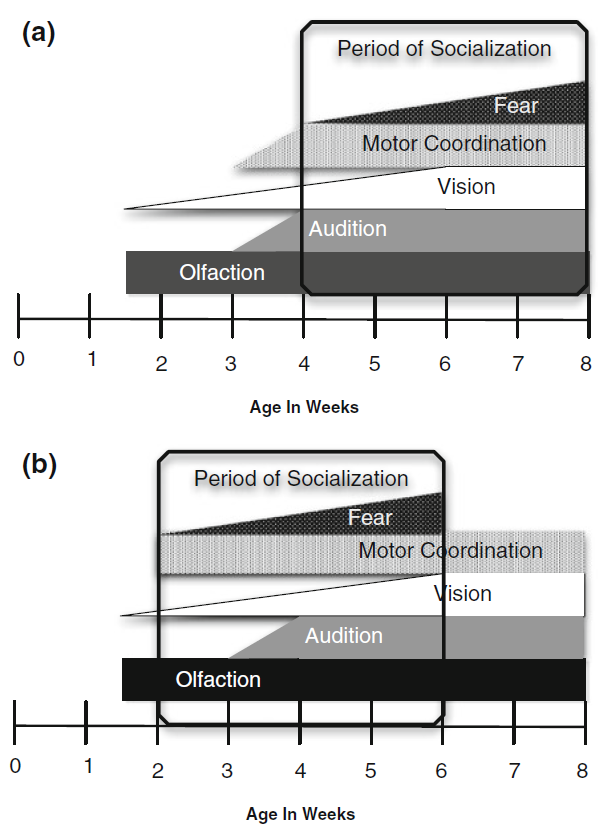
(a) Dogs begin to explore the world around them at four weeks of age using sight, hearing, and smell. Later, all these senses show dogs when they’re safe.
(b) Wolves begin to explore the world at two weeks of age using only smell. Later, only smell shows wolves when they’re safe, and much is novel and frightening.
Dogs adapted to socialize with people
While it is possible to tame a wolf, the process is much more intensive than that required to produce a tame dog. Wolves require twenty-four hours contact a day starting before three weeks of age… …around four weeks old… they begin to bite their sleeping human companions and thus co-sleeping with humans ends, but the pups still spend all their waking hours in the presence of people. This socialization process continues until the pups are four months old…
Dogs require as little as ninety minutes of contact with humans during their ‘critical period’ of socialization—one of the critical periods of development… —to form a social attachment…
The critical period for socialization begins with the ability to walk and explore the environment… The critical period of socialization closes with the avoidance of novelty, when an animal runs away from, rather than approaching and exploring, novel objects.
Wolves begin to walk and explore at two weeks of age… And wolves don’t show the avoidance of novelty—the true ‘‘onset of fear’’—until six weeks of age.
Dogs do not start to walk and explore until four weeks… …fear gradually increases… until around eight weeks when they will run away from a truly novel stimulus (a stimulus having no familiar characteristics).
Thus wolves and dogs both have a four-week critical period for socialization—wolves just go through it two weeks earlier than dogs do.
…dogs and wolves… developed the ability to see, hear, and smell at the same time. The consequence of this is that dogs began to explore the world around them at four weeks of age with the senses of sight, hearing, and smell available to them, while wolves began to explore the world at two weeks of age when they had the ability to smell but while functionally blind and deaf… This change in the interaction between the developing senses and the critical period for socialization means that dogs can generalize familiarity using all of their senses, while wolves must rely primarily on their sense of smell, making more things novel and frightening as adults.
Dogs adapted to forage near people
Dogs… no longer have to spend as much energy and ingenuity foraging. Rather than hunting prey, dogs can rely on human refuse, which is more predictably located and available year round. Foraging on garbage is a less complex behavior pattern than hunting and dog pups can forage even before they are entirely weaned. Thus, by the time they are ten weeks old they are perfectly capable of finding their own food…
Dogs adapted to populate near people
Dogs have lost seasonality of reproduction: in other words they do not reproduce solely at a particular time of year… Dogs also reach sexual maturity faster than wolves and can reproduce during their first year of life… Furthermore, dogs are polygamous, in contrast to wolves, which are generally monogomous… Thus dogs show no pair bonding and protection of a single mate, but rather have multiple mates in a year.
Wolves, and in fact all of the wild members of the genus Canis, display complex coordinated parental behaviors. Wolf pups are cared for primarily by their mother for their first three weeks of life… During this time she remains in the den with them while they rely on her milk for sustenance and her presence for protection from predators. Because of this she cannot spend much time away from them, and the father brings the mother food during this period. Once the pups come out of the den and have enough teeth to chew, the father, mother as well as some pups from previous years, begin to regurgitate food to the pups… Wolf pups become independent by five to eight months, although they often stay with their parents for years…
Dogs, on the other hand, show greatly reduced parental behavior. Pups are still cared for by the mother. They rely on her for milk and protection just like wolves. However, unlike wolves, the mother gets no help from any other dogs during this time. There is no paternal care, let alone help from older siblings. Once pups are weaned at around 10–11 weeks they are independent and receive no further maternal care…
Dogs adapted to love people
…dogs are canids that have come to occupy a new niche through natural selection.
The real differences between dog and wolf behavior lie at… basic levels: in the process of socialization, in foraging, and in reproduction.
The intertwined changes… are small but they have massive downstream effects. These indirect consequences include the fact that we have dogs resting at our feet and not wolves.
- Udell, Monique AR, et al. “A dog’s-eye view of canine cognition.” Domestic Dog Cognition and Behavior. Springer Berlin Heidelberg, 2014, pp. 221-240.